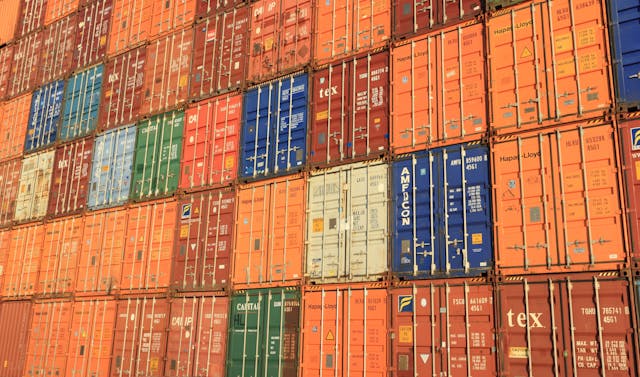A comprehensive analysis of Container classification and uses: an essential guide for freight forwarders and foreign trade personnel
 2025-03-28
2025-03-28
 24
24
Hello everyone, today we are going to talk about the classification and use of Container. For freight forwarders and foreign trade personnel, understanding different types of Container and their applicable scenarios can not only improve work efficiency, but also avoid unnecessary troubles during transportation. Below, I will analyze the classification of Container in detail from three aspects: use, main material and structure.

1. By purpose
(1) Dry Cargo Container
Dry Container, also known as Grocery Container, is the most common type of generic Container. It is mainly used for loading general groceries except liquids, goods that need temperature regulation and special goods. This Container has a very wide range of uses, and common sizes come in 20 'and 40'. Its structure is characterized by a closed design, usually with a box door at one end or side to facilitate loading and unloading of goods.
(2) Open Top Container
Open-top Container, as the name suggests, does not have a rigid box top, but rather a canopy made of canvas, plastic sheet or plastic-coated cloth supported by foldable top beams. Other structures are similar to dry goods Container. This Container is suitable for loading tall large goods and heavy goods that need to be hoisted, such as mechanical equipment, steel, etc.
(3) Platform-based Container (Platform Based Container)
Bench-type Container has no box top and side walls, and some even have the end walls removed, only the bottom plate and four corner posts. This Container has a thicker bottom and stronger strength than ordinary Container, so it is suitable for loading goods of different shapes. The platform Container has only a bottom plate and no superstructure. It is very convenient for loading and unloading operations and is suitable for loading long and heavy goods.
(4) Ventilated Container
The ventilation Container is equipped with ventilation holes on the side wall or end wall, which is suitable for loading goods that do not need to be frozen but need ventilation to prevent sweat, such as fruits and vegetables. It can also be used as a grocery Container if the vent is closed.
(5) Refrigerated Container
Refrigerated Container is specially designed for transporting frozen or low-temperature goods that need to be maintained at a certain temperature. It is divided into built-in mechanical refrigeration Container with freezer and external mechanical refrigeration Container without freezer. Suitable for loading meat, fruit and other goods. It should be noted that the cost and operating cost of refrigerated Container are relatively high. When using it, special attention should be paid to the technical status of the refrigeration device and the required temperature of the goods in the box.
(6) Bulk Container
In addition to the outside of the container door, the bulk cargo Container also has 2 ~ 3 loading ports at the top of the container, which is suitable for loading powdery or granular goods. When using it, pay attention to keeping the box clean and smooth on both sides, so as to facilitate the Break bulk of goods from the box door.
(7) Animal Container
Animal Container is a Container exclusively for shipping livestock. In order to achieve good ventilation, the box walls are manufactured with wire mesh, and there are sweeping and draining ports below the side walls, and feeding devices are provided.
(8) Tank Container
Tank Container is specially set up for transporting liquid goods, such as alcohol, oil and liquid chemicals. It consists of two parts: tank body and box frame. During loading, the goods enter through the top loading hole of the tank, and during Break bulk, the goods flow out through the discharge hole or are sucked out from the top loading hole.
(9) Car Container
The automobile Container is designed and manufactured specifically for shipping small cars. Its structural feature is that there is no side wall, only a frame and a box bottom, and it can load one or two floors of cars.
2. Classification by main material
(1) Steel Container
The steel Container's frame and box siding are made of steel. The biggest advantages are high strength, strong structure, good weldability and watertightness, low price, easy repair, and not easy to damage. The main disadvantages are heavy weight and poor corrosion resistance.
(2) Aluminum Container
There are two kinds of aluminum Container: one is steel frame aluminum plate; The other only uses steel at both ends of the frame, and aluminum for the rest. The main advantages are light weight, no rust, beautiful appearance, good elasticity, and not easy to deform. The main disadvantages are high cost and easy damage in collision.
(3) Stainless steel Container
Container made of stainless steel generally uses stainless steel to make tank Container. The main advantages are high strength, no rust and good corrosion resistance, but the disadvantage is large investment.
(4) Container made of fiberglass
FRP Container is composed of FRP composite panels installed on steel frames. The main advantages are good heat insulation, anti-corrosion and chemical resistance, high strength, easy cleaning, simple repair, large internal volume of the Container, etc.; The main disadvantage is its heavy dead weight and high cost.
3. Classification by structure
(1) Interior Post Type Container and Outside Post Type Container Container
Mainly refers to the aluminum alloy Container, and the inner column Container means that the side column (or end column) is located within the side wall or end wall; An outer column Container is when the jamb (or end column) is located outside the sidewall or end wall.
(2) Foldable Container
All the main components of the folding Container (side walls, end walls, box top, etc.) can be simply folded or disassembled, and can be conveniently reassembled when reused.
(3) Thin-shell Container
All the components of the thin-shell Container form a steel body, which has the advantage of being light in weight and adapting to the torque forces that occur without causing permanent deformation.























